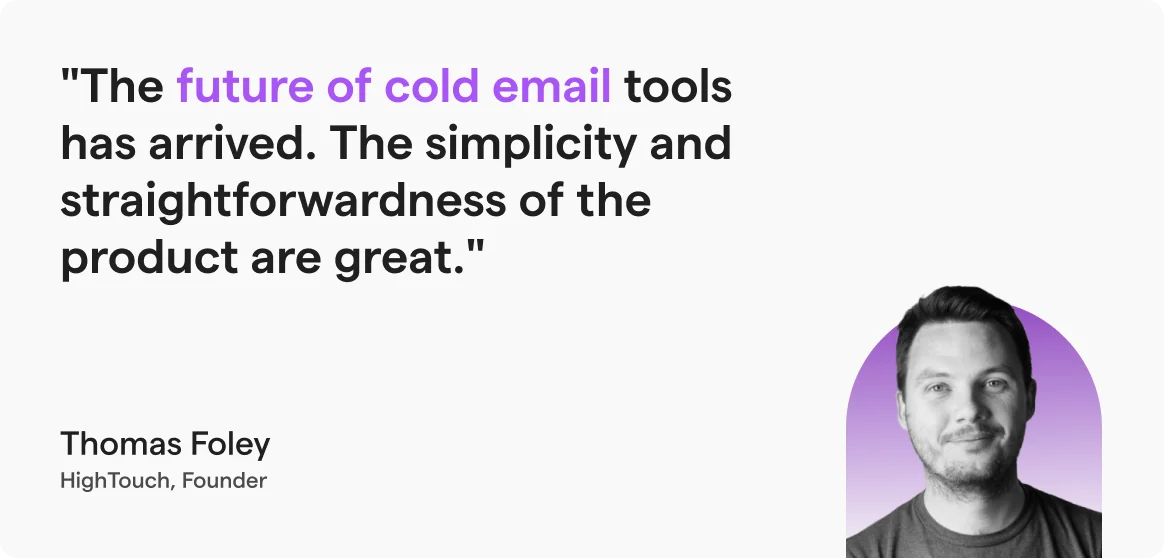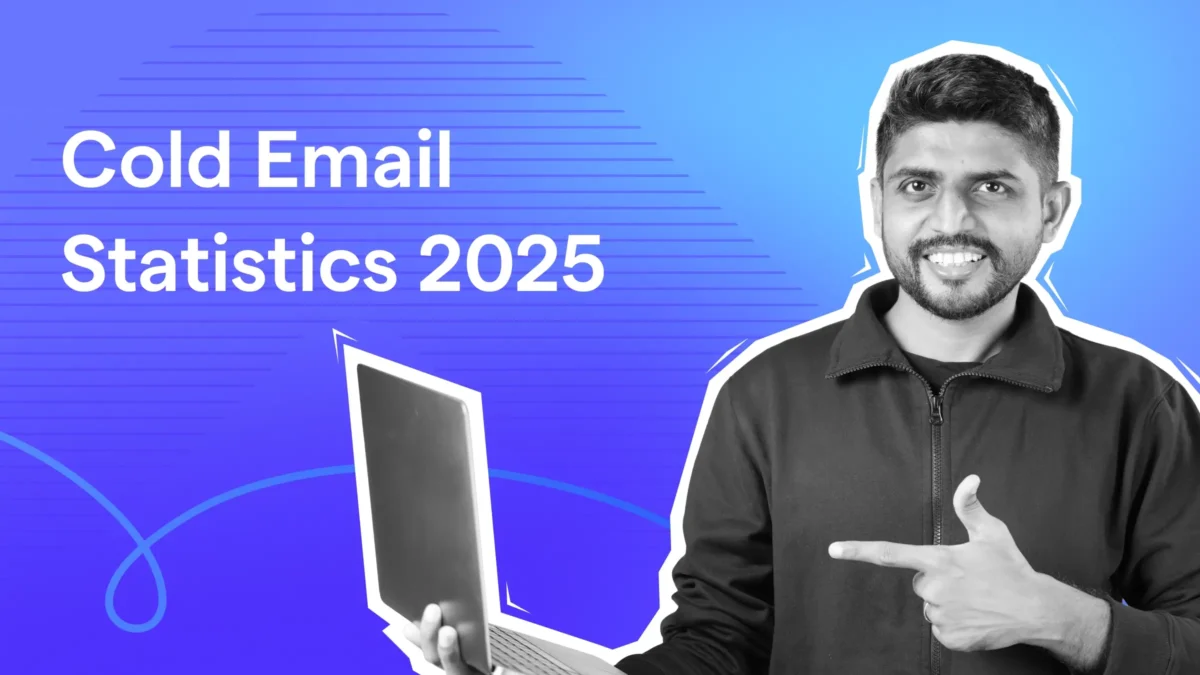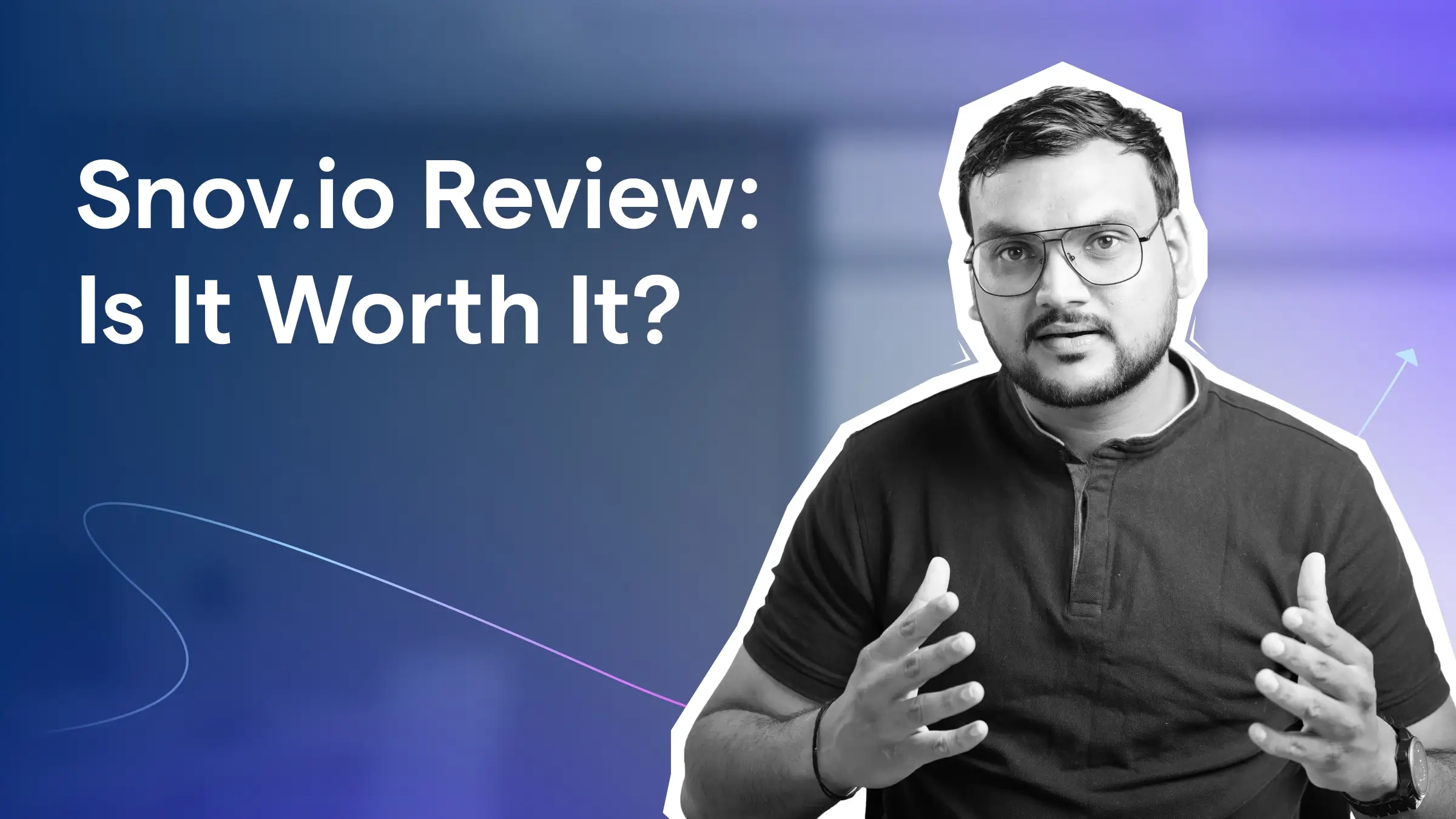Contents
- 1 30-Second Summary
- 2 Cold Email Statistics: Table of Contents
- 3 18 Useful Cold Email Statistics for 2025
- 3.1 1. What Is the Average Cold Email Reply Rate in 2025?
- 3.2 2. Emails Are About to Have 4.9 Billion Global Users by 2027
- 3.3 3. How High Should Your Bounce Rate Be Before You Worry?
- 3.4 4. Why Do Cold Email Unsubscribe Rates Matter?
- 3.5 5. Does Open Rates Still Matter?
- 3.6 6. When Done Right, Cold Email Can Give You 20% Conversion Rates
- 3.7 7. When’s the Best Day to Send a Cold Email?
- 3.8 8. Personalized Subject Lines Can Boost Reply Rates by 35%!
- 3.9 9. How Long Does It Take for a Cold Email to Give the Best Results?
- 3.10 10. Do Follow-Ups Actually Get More Replies?
- 3.11 11. How Much Impact Does a CTA Have on Cold Email Clicks?
- 3.12 12. Does A/B Testing Really Work for Cold Email Campaigns?
- 3.13 13. Can Segmentation Improve Your Cold Email Results?
- 3.14 14. Why Are Targeted Email Lists a Game Changer?
- 3.15 15. Do Spammy Words Kill Your Cold Email Deliverability?
- 3.16 16. Should You Add Hyperlinks to Cold Emails? (Click Rate)
- 3.17 17. Does Cold Email Still Deliver Strong ROI in 2025?
- 3.18 18. The Importance of Warm-Up and Using Proper Tools for Cold Emailing
- 4 Got the Data? Now Set Up Your Campaign!
- 5 Cold Email Statistics: FAQs
30-Second Summary
Cold emails are very effective in 2025, but only when you know the data.
I’ve covered all the necessary cold email statistics in this blog, including average reply, open, unsubscribe, and even conversion rates.
Along with that, I’ve also shared some useful tips that will help you get better results than average rates.
Did you know that over 68% of B2B decision-makers still prefer email as their go-to channel for cold outreach?
Yet, the average reply rate still sits at 4% in 2025.
So, why the massive gap?
With more than 160 billion emails sent every single day, most never make it past spam filters or stand out in overflowing inboxes.
So, what is the good news here?
When done right, cold emailing can still deliver outstanding results. But to succeed, you need to know what’s working (and what’s not) in 2025.
That’s why I’ve put together 18 key cold email statistics to help you shape smarter, more effective outreach strategies this year.
Let me share them all!
Cold Email Statistics: Table of Contents
18 Useful Cold Email Statistics for 2025
There are several factors that can contribute to the success of a cold email campaign.
In this section, I’ve handpicked the most relevant cold email statistics in 2025 and backed them with reliable data.
P.S. Some data can also be influenced by the industry it originates from, so I’ve made sure to highlight that as well.
Let’s look at the cold email statistics for 2025:
- What Is the Average Cold Email Reply Rate in 2025?
- Emails Are About to Have 4.9 Billion Global Users by 2027
- How High Should Your Bounce Rate Be Before You Worry?
- Why Do Cold Email Unsubscribe Rates Matter?
- Does Open Rates Still Matter?
- When Done Right, Cold Email Can Give You 20% Conversion Rates
- When’s the Best Day to Send a Cold Email?
- Personalized Subject Lines Can Boost Reply Rates by 35%!
- How Long Does It Take for a Cold Email to Give the Best Results?
- Do Follow-Ups Actually Get More Replies?
- How Much Impact Does a CTA Have on Cold Email Clicks?
- Does A/B Testing Really Work for Cold Email Campaigns?
- Can Segmentation Improve Your Cold Email Results?
- Why Are Targeted Email Lists a Game Changer?
- Do Spammy Words Kill Your Cold Email Deliverability?
- Should You Add Hyperlinks to Cold Emails? (Click Rate)
- Does Cold Email Still Deliver Strong ROI in 2025?
- The Importance of Warm-Up and Using Proper Tools for Cold Emailing
1. What Is the Average Cold Email Reply Rate in 2025?
On average, only 5.8 % of cold emails get a response.
But, this rate can differ based on the industry:
| E-commerce | 4.80% |
|---|---|
| Manufacturing & Distribution | 4.30% |
| Finance & Banking | 3.30% |
| IT & Consulting | 3.50% |
| Consulting Services | 2% |
| Software / SaaS | 1.90% |
The gap between industries largely comes down to channel saturation.
In competitive sectors like SaaS, inboxes are overloaded with outreach, while niche or mission-driven sectors (like nonprofits and legal services) benefit from more relevance and less noise.
However, you can consider these metrics to see if your campaigns are successful or not:
- Average: 5% to 10%
- Good: 10% and above
- Top performers: 20% or even higher.
- Poor: Below 5%.

But you know what’s common? Over 71% of decision-makers ignore emails simply because they don’t address their needs.
Add to that the inbox overloads (most consumers receive over 10+ cold emails per week) and stricter spam filters make it hard to reach your recipients.
So, how can you increase the reply rates?
- Run small, targeted campaigns: Reports show sequences with 100 recipients or fewer get 5.5% reply rates on average.
However, when the contacts exceed 1000, it’s challenging to achieve a reply rate of over 2.1%. - Keep your content short and to the point: As emails with 50–125 words can get an impressive 50% reply rate.
Because short emails can quickly give out the message. - Write what’s relevant: Every part of your email should address the recipient’s pain points or requirements.
So if you want good reply rates, focus on quality over quantity.
Focus on sending targeted, concise, and relevant emails, compared to generic ones.
More is not always better 😉
Use AI Variant and A-Z Testing to 3X Your Response Rates with Saleshandy.
2. Emails Are About to Have 4.9 Billion Global Users by 2027
Email outreach will continue to be the most effective way to reach people at scale.
Because the global number of email users is expected to reach 4.89 billion.
By 2027, more than 408.2 billion emails are expected to be sent every day.

However, this will also increase the challenge of avoiding evolving spam filters.
With spam rates reaching around 46% of all email traffic, email service providers are likely to become even stricter.
To avoid being caught by spam filters, your cold email campaigns should be highly personalized, deliver genuine value, and be sent in accordance with the laws.
3. How High Should Your Bounce Rate Be Before You Worry?
A high bounce rate can easily hurt your cold email campaigns.
The average bounce rate for B2B cold emails is around 7.5%. However, this can change based on the industry.
Here are some average email bounce rates by industry according to various sources:
- Real Estate: 4.56%
- Retail / Consumer Services: 4.16%
- Agencies: 3.15%
- Financial Services: 1.79%
- Legal Services: 2.39%
- Retail: 2.55%
- Manufacturing and Distribution: 14.83%
This might confuse you, so to give you a better idea:
- If it’s around 3-5%, then it’s considered safe
- When it rises over 6% then you need to check why it’s happening.
- However, anything above 7% is bad, and it will affect your sender reputation.
This is one of the few metrics where more doesn’t mean better.
You should make sure to keep it law. I would suggest:
- Maintain a hygiene lead list by collecting data from verified databases and updating it at regular intervals.
- Warm up your domain.
- Authenticate your emails
Keep bounce rates low using verified data from Saleshandy’s Lead Finder
4. Why Do Cold Email Unsubscribe Rates Matter?
It is legally required to add unsubscribe options in your cold emails.
Based on the data from the interaction with this button, you will know how many are interested in your campaigns, and if you need to rework.
On average, the usual cold email unsubscribe rate is around 2.17%.
Anything that exceeds this threshold requires intervention, and if it reaches 5%, it will impact your sender’s reputation.
Unlike traditional email marketing, a moderate unsubscribe rate in cold outreach isn’t always a bad thing.
As it’s just people with less intent opting themselves out rather than marking your email as spam.
However, it’s good to know the average unsubscribe rate across the industries.
- Business & Finance: 0.15%
- Education & Training: 0.18%
- E-commerce: 0.19%
- IT/Tech/Software: 0.20%
- Healthcare Services: 0.30%
- Wellness & Fitness: 0.40%
Okay, but how can you keep the unsubscribe rate low? All you have to do is:
- Target the right audience
- Adjust your frequency
- Provide proper value with each of your outreach efforts
Usually, this helps to keep your unsubscribe rate under the average.
However, if it spikes, it’s better to pause your campaign to see what the issue is, or to start an entirely new one by addressing the issues.
5. Does Open Rates Still Matter?
Open rate has long been seen as the “vanity metric” of email marketing, and for good reason.
In 2025, average cold email open rates fall between 20% and 40%, depending on the industry.
Average Cold Email Open Rates by Industry
- Software & Web Apps: 38.1%
- Marketing & Advertising: 39.0%
- Business & Finance: 43.2%
- Consulting: 45.7%
- Healthcare: 22–23%
- Technology: 18–21%
- Real Estate: ~20%
(Sources: Mailchimp, Campaign Monitor, industry studies)
Why Open Rate Isn’t Always Reliable
While open rates give a general benchmark, they’re not as trustworthy as they used to be. Here’s why:
- Privacy updates: Apple’s Mail Privacy Protection and similar features block open tracking, inflating results.
- Spam filter scanning: Security tools often auto-open emails to scan them, which artificially boosts open stats.
- Prospect behavior: Many people glance at an email without reading or engaging, so an “open” doesn’t mean much.
The Better Metric is Replies
While A high open rate is good, it shows your subject lines are working and your emails are being delivered.
But reply rate is the real measure of success. It tells you whether your message resonated enough to spark a conversation.
Still, you can use open rate as a supporting metric for:
- Testing subject lines (short vs. personalized)
- Monitoring deliverability (a sudden drop signals inboxing issues)
- Improving previews (using compelling preheaders can lift opens by 10%+)
Use open rate to test subject lines and monitor deliverability, but always measure success by reply rates and conversions, not just opens.
6. When Done Right, Cold Email Can Give You 20% Conversion Rates
In cold emailing, conversion rate means the person you emailed did what you wanted them to do.
This can be anything, including:
- A reply to your email
- Scheduling a meeting or call
- Ssource
- Making a purchase
Because of this, benchmarks vary widely.
On average, the cold email conversion rate is around 1% and 5%.
For B2Bs, the average conversion rate is around 1.7–5%.
As for B2C, this can be around 1-3%

However, with relevant content and proper follow-ups, you can increase it to even double digits, sometimes as high as 15–20%!
These are the factors that mainly influence conversion rates:
- Writing personalized and relevant content
- Offering proper value.
- Using less or one, but a strong CTA
- Doing proper Follow-ups
For conversion rates, I would suggest setting a realistic goal based on industry, goals, and resources.
7. When’s the Best Day to Send a Cold Email?
Sending your cold emails on the right day can significantly improve open and reply rates.
The data shows clear patterns but also some nuance depending on the audience and industry.
Best Days for B2B Cold Email (According to Studies)
- Tuesday: Often cited as the #1 day for opens and replies (HubSpot, Martal Group). Open rates are 16% higher than average.
- Wednesday: A strong performance is expected as professionals are mid-week and in a productive mindset.
- Thursday: Still effective, especially for prospects planning ahead before the weekend.
- Monday: Mixed results. Lemlist and Siege Media found Mondays can perform surprisingly well if sent early (6–9 AM PST), because inboxes are less saturated.
- Friday: Generally weaker as professionals wind down for the weekend.
Best Times to Send Cold Emails
Most studies agree that mornings work best:
- 8–10 AM local time: Peak engagement window.
- 1–3 PM local time: Secondary sweet spot, catching people after lunch.
- Executives: Very early (5–8 AM) can be effective, as leaders often check email before their workday begins.
Key Takeaways for Send Timing
- Start mid-week: Tuesday, Wednesday, and Thursday are the safest bets for B2B.
- Avoid Friday afternoons: Engagement drops sharply.
- Match your audience: B2C and e-commerce emails may perform better in evenings or even weekends.
- Always A/B test: Timing is highly audience-specific. Use analytics to refine your send strategy.
While Tuesdays consistently lead in reply rates, there is no universal “perfect day.”
The real secret is to test different days and times for your specific industry and audience, then double down on what works.
8. Personalized Subject Lines Can Boost Reply Rates by 35%!
Your Subject line is the hook that will catch the recipient’s eye (not literally) from the crowded inbox.
Studies show personalized subject lines can outperform generic ones by 20–35%!
What to include in your personalized subject line?
- Name of the recipient/company: Quick question, John
- Address company pain points or goals: How [Company] can reduce churn by 20%
- Use something contextual (events/connections): Saw your LinkedIn post on scaling teams, here’s a quick idea
And along with that, you should also make sure to:
- Keep your subject line short (with under 50 characters).
- Use numbers, questions, or specific pain points to grab attention.
- And DON’T use spammy words like free, guaranteed, or act now.
This, and a strong but personalized email content can help you a lot in converting your recipients.
9. How Long Does It Take for a Cold Email to Give the Best Results?
Cold emailing is not a channel that delivers instant results.
While a few recipients may respond within hours or a day, most take longer.
The average cold email response time is 7–10 days.
After that, the chances of a reply drop significantly unless you send a follow-up.
Here’s how you can increase your chances of getting early replies:
- Address your recipient’s pain point well, while keeping your emails short.
- Send emails in the middle of the week (Tuesday–Thursday) that too, in the morning as your recipients will be less packed compared to other days.
- Generic templates are usually ignored, let alone getting a reply. So always personalize your emails.
Even after following this, you might still not get replies, as your recipients could be busy with their schedule or might have missed your message entirely.
This is where you need to do proper follow-ups.
Most cold email replies don’t happen after the first message.
In fact, up to 70% of replies come from follow-ups!
I’ve shared more stats about follow-up and some tips in the next section.
10. Do Follow-Ups Actually Get More Replies?
Yes, follow-ups are often where the magic happens.
Many prospects don’t respond to the first email, but a polite reminder or added value nudge can dramatically improve your chances.
According to Belkins, the first follow-up email can increase reply rates by 49%. Sending 2–3 follow-up emails can lift response rates by up to 65.8%.

How Many Follow-Ups Work Best?
- First follow-up: +49% replies
- Second follow-up: +3% more
- Third follow-up: Effectiveness drops by ~30%
- Beyond 3–4: Diminishing returns + risk of being flagged as spam
Best Practices for Follow-Up Sequences
- Start politely: Gently remind them of your initial email.
- Add value: Share a case study, resource, or insight in the second email.
- Keep it light: Use a low-pressure close like “Should I circle back next quarter?”
- Watch engagement signals:
- If they open but don’t reply: Adjust your timing or approach.
- If no one opens at all: Rework your subject line or send time.
Timing matters too; mid-mornings on Tuesdays or Thursdays are often the sweet spots.
Follow-ups aren’t optional; they’re essential.
A well-timed sequence of 2–3 follow-ups can nearly double your reply rates, while sending too many can hurt your reputation.
Strike a balance: persistent, but respectful.
Automate smart follow-ups with Saleshandy.
11. How Much Impact Does a CTA Have on Cold Email Clicks?
A CTA will tell your recipients what to do next.
And a clear, well-written CTA can play a big part in your conversion rates.
I’ve analyzed thousands of emails over the years.
And from what I’ve seen, the best-performing CTAs are between 4–8 words long.
In fact, 6-word CTAs consistently deliver the highest click-through rates (CTR) of 10–20%!
Anything longer than 10 or more is usually skipped.
Now, here are some tips for your cold email CTAs
- Softer CTAs like Worth a quick chat? or “Open to learning more? Works better compared to the pushy ones.
- Action words like schedule, explore, and get started work better than passive phrases.
- Better to keep your hyperlinks to 1, or max 2. Too many links trigger spam filters.
- Add trust signals by mentioning mutual connections, case studies, or social proof.
Keep it simple, and focus on lowering the barrier to action.
12. Does A/B Testing Really Work for Cold Email Campaigns?
Yes. When done properly, A/B testing can almost double your open and reply rates!
Here’s how A/B testing works:
- Create two versions of your email with different variables (best to change only one at a time)
- Send each version to a random segment of your list.
- Compare results on metrics like open, reply, or click-through rates.
I run A/B tests with my subject lines, email content, CTAs, and even the timing.
Here are some tips for A/B testing:
- Use a large enough sample (at least 1,000 prospects per variation).
- Track key metrics such as reply rate and conversion rate.
- Continue running A/B tests, as they will help you refine your campaigns.
By systematically experimenting with subject lines, CTAs, and timing, you can gather data that will significantly improve your cold email campaigns.
13. Can Segmentation Improve Your Cold Email Results?
Yes. Segmented campaigns see 14.3% higher open rates and 10.9% higher conversion rates.
Because you will be able to craft more effective cold emails for each segment and address directly what each prospect cares about.
78% of email marketers agree that segmentation is one of the most effective strategies for email marketing.
Why Segmentation Works?
- Increased relevance & personalization
- Higher engagement rates
- Better deliverability
- Higher conversions & ROI
So, how to segment your emails? I usually do it on the basis of:
- Demographics: Job title, industry, location
- Firmographics: Company size, revenue, tech stack
- Behavioral: Website visits, previous downloads, past engagement
- Lifecycle stage: Awareness vs. consideration vs. decision-making
Cold emails sent to segmented lists get higher opens, clicks, and replies, and even boost revenue by up to 760%.
14. Why Are Targeted Email Lists a Game Changer?
After segmenting leads, you’ll create a targeted email list.
This will help you address their challenges and goals to build a strong connection.
The results are higher engagement and better conversions.
Here are some of the benefits of targeted email lists:
- 14.3% higher open rates and 100%+ higher click-through rates compared to non-segmented campaigns.
- 6x higher conversion rates (targeted emails generate 58% of all email marketing revenue).
- 50% lower unsubscribe rates when emails are targeted and relevant.
- Improve your deliverability rates.
To get these results, invest in high-quality data providers, and also regularly remove invalid or inactive contacts
15. Do Spammy Words Kill Your Cold Email Deliverability?
Yes. Spammy words can hurt deliverability, but modern spam filters are far stronger than just scanning for a blacklist of terms.
Today’s filters use AI, machine learning, and engagement data to judge the overall quality and intent of your email.
That means a single word like “free” won’t automatically doom your message, but when combined with poor sending practices, spammy phrasing can raise your risk of hitting the junk folder.
Here are some stats about spam
- Words like “click” appeared 147% more often in spam, and “winner” showed up 81.5% more often, but context matters.
- 1 in 6 emails lands in spam, proving deliverability is a multi-factor challenge.
- After replacing aggressive “salesy” wording with value-focused language, a startup saw a 40% lift in open rates and 35% fewer spam flags.
- There are also reports confirming that filters understand context, using a word like “free” in a genuine, relevant message won’t necessarily get flagged.
So what triggers these spam filters?
- Low Sender Reputation: Spam filters check your domain history, authentication (SPF, DKIM, DMARC), and engagement.
- Shady Content Patterns: Too much formatting, links, and spammy words raises red flags.
- Overall intent: Filters detect whether your email reads like a real, one-to-one conversation or is just a bulk promo blast.
Here’s how you can keep your cold emails safe from spam filters:
- Write like a human, not a marketer, keep tone conversational.
- Use value-driven language: focus on solving problems, not hyping offers
- Limit links (1–2 max) and avoid formatting gimmicks.
- Proofread for clarity.
Spammy words don’t kill deliverability on their own but patterns of spammy behavior do.
So focus on writing authentic, personalized, and value-first emails that make you sound like a real person.
Never Land in Spam Again
Protect Your Deliverability with Inbox Radar by Saleshandy
16. Should You Add Hyperlinks to Cold Emails? (Click Rate)
Hyperlinks in cold emails are a double-edged sword: they can boost click rates, but they also raise red flags with spam filters, especially in your very first touch.
That’s why most cold email experts recommend avoiding links in your initial email. Instead, focus on building trust and starting a conversation.
Once a prospect engages, links can be used strategically in follow-ups.
The Case Against Links in First-Touch Cold Emails
- Increased spam risk: ESPs like Gmail and Outlook are strict about links, especially tracking links, which are commonly flagged.
- Lower trust: Prospects don’t know you yet. Dropping a link immediately feels pushy or suspicious.
- Shifts the goal: The first cold email should drive a reply, not a click. A link often provides them with a way out without initiating a conversation.
From my research, I found that:
- 1–3 links can increase CTR by ~15% in warmed-up campaigns.
- Cold emails with links experience 27–35% higher spam rates and Mailshake.
Best Practices for Using Links in Cold Emails
- Avoid links in the first email: Prioritize replies over clicks.
- Use plain, non-tracking links. If you must include one, ensure it has a clean URL (free from UTM clutter).
- Introduce links in follow-ups: Share case studies, blogs, or booking links only after establishing interest.
- Keep it minimal: 1 link max per email. More than 2 looks spammy.
Hyperlinks can increase engagement, but timing is everything. Skip links in your first-touch cold email and focus on getting replies. Once trust is built, a single, relevant link in a follow-up can improve click-through rates without hurting deliverability.
17. Does Cold Email Still Deliver Strong ROI in 2025?
Yes. Cold Email gives an ROI of $36–$42 per $1 spent.
Cold Emailing is still a great way to do outreach, especially for startups and small businesses that are limited in capital.
However, if you combine cold email with multi-channel outreach (LinkedIn and phone number), you can even get an ROI of 287%!
You can use this formula to check the ROI of your email outreach campaigns:
ROI (%) = (Revenue – Cost) ÷ Cost × 100
To make it accurate, track:
- Campaign costs: tools, list building, labor
- Revenue generated: booked meetings, closed deals
- Supporting metrics: opens, replies, conversions, spam complaints
Okay, but how can you achieve a strong ROI from your cold email outreach? I usually follow these steps:
- Invest in list quality
- Don’t skip follow-ups
- Send short and personalized emails
- Lastly, always A/B test your campaigns.
When done right, Cold email in 2025 is still one of the highest-ROI channels.
18. The Importance of Warm-Up and Using Proper Tools for Cold Emailing
Even the best-written cold emails can fail if they don’t land in the inbox.
And often, that’s not about what you wrote, but how you sent it.
Email providers like Gmail and Outlook evaluate every sender based on their reputation.
If a new or inactive account suddenly sends hundreds of emails, it raises red flags, and your emails are pushed to spam.
In fact, studies show that 57% of emails land outside the inbox without proper warm-up.
So it’s very important to warm up your emails as it:
- Builds sender reputation gradually.
- Protects your domain from blocklists and throttling.
- Simulates positive engagement (opens, replies, marks-as-important).
While manual warm-up is possible, it is a slow and resource-heavy process. It’s best to let it be handled by the right tools.
As not only do these tools help you warm up your email accounts, but they also help you run cold email campaigns while ensuring your deliverability score is in check.
Let’s take Saleshandy as an example. It lets you combine warm-up + outreach in one platform, making it easier to scale cold emails without hurting deliverability.
Got the Data? Now Set Up Your Campaign!
So yeah. I’ve shared the data on what’s working on cold emailing now.
Next up is to put this data into action. For that:
- Start with clean, targeted lists to avoid high bounce rates.
- Ensure to send short, personalized, and relevant content only.
- Understand the importance of follow-ups, and make sure to send them.
- Use the right tools to warm up and send your cold emails..
The old way of sending the same template to thousands is not going to work with cold emailing anymore.
This new way is about establishing a connection and building trust.
I hope this data will help you make and run amazing campaigns.
Cold Email Statistics: FAQs
1. Is cold emailing still effective for B2B sales in 2025?
Yes. Cold emailing is still highly effective for B2B sales in 2025. As many decision makers still prefer to be reached out to by cold email.
However, you need to ensure your campaigns are targeted, personalized, and value-driven. Along with that, you also need to make sure to do consistent follow-ups.
Cold email also has the strongest ROI, making it one of the most cost-effective channels available.
2. Cold Email vs LinkedIn Messaging: Which Gets Better Response Rates?
Cold email generally works better for scalability, with average reply rates around 4–8%.
LinkedIn messages can see higher reply rates (10–25%), but you’re limited in how many people you can reach, and results depend heavily on your profile and network.
The best strategy? Use both. Start with cold email for scale, then follow up with a LinkedIn touch to boost engagement.
3. Is cold emailing legal?
Yes, cold emailing is legal in most countries if you follow regulations like CAN-SPAM (US) and GDPR (EU).
That means:
- Use accurate sender information.
- Always include an easy opt-out/unsubscribe option.
- Only email people where there’s a legitimate business interest.
As long as you follow these rules and avoid spamming, cold emailing is a compliant and widely used B2B strategy.
4. B2B vs B2C: Where Does Cold Email Work Best?
Cold email works best for B2B, where decision-makers value relevant, solution-focused outreach that starts conversations and builds long-term relationships.
For B2C, cold emailing is far less effective. Most consumers see unsolicited emails as spam, and many regions restrict or ban them altogether.







